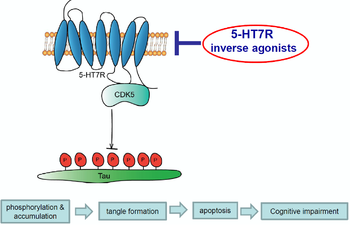Novel treatment of dementia-associated tauopathies
Keywords
Alzheimer’s disease,dementia-associated taupathies,serotonin 5-HT7 receptor,5-HT7R,dementia
Challenge
One of the main causes of dependency and disability among the elderly worldwide is dementia. In 60-70% of the cases, the underlying condition of dementia is Alzheimer’s disease (AD), most frequently tauopathy. At present, only 5 medications for the treatment of AD are approved, all of which treat symptoms. The mechanism of pathogenicity in tauopathies has been shown to be the hyperphoshorylation of Tau protein which in turn results in the formation of Tau tangles in nerve cells and leads to network malfunctions and neuronal death. The challenge is to target the pathogenic mechanism pharmaceutically.
Technology
Candidate molecules are serotonin 5-HT7 receptor inverse agonists for use in preventing or treating tauopathies. The inverse agonist prevents hyperphosphorylation of the Tau protein (p-Tau). In the neuroblastoma cell line model expressing mutated human Tau, an inverse agonist reversed accumulation of Tau, p-Tau and Tau aggregates. Immunfluorescence confirmed the prevention of Tau aggregates formation. Blockade of constitutive receptor activity in neurons that overexpressed pathological Tau prevented Tau hyperphosphorylation, aggregation, and neurotoxicity. Moreover, receptor knockdown in prefrontal cortex fully abrogated Tau-induced deficits in long term potentiation and memory impairments. Application of approved drugs possessing inverse agonism towards the 5-HT7R demonstrate similar favorable effects both in vitro and in vivo.
Commercial Opportunity
Licensing and/or co-development.
Development Status
In vivo data. Preclinical development.
Patent Situation
European and US applications based on WO2020/065090 with priority of 2018 are pending.
Further Reading
Bijata et al., 2017. Synaptic remodeling depends on signaling between serotonin receptors and the extracellular matrix. Cell Reports.
Speranza et al., 2017. Serotonin 5-HT7 receptor increases the density of dendritic spines and facilitates synaptogenesis in forebrain neurons. J of Neurochem.
Wirth et al., 2017. How serotonin receptors regulate morphogenic signalling in neurons. Prog Neurobiol.
Butzlaff and Ponimaskin, 2016. The role of Serotonin Receptors in Alzheimer’s disease. Opera Med et Physiol.





